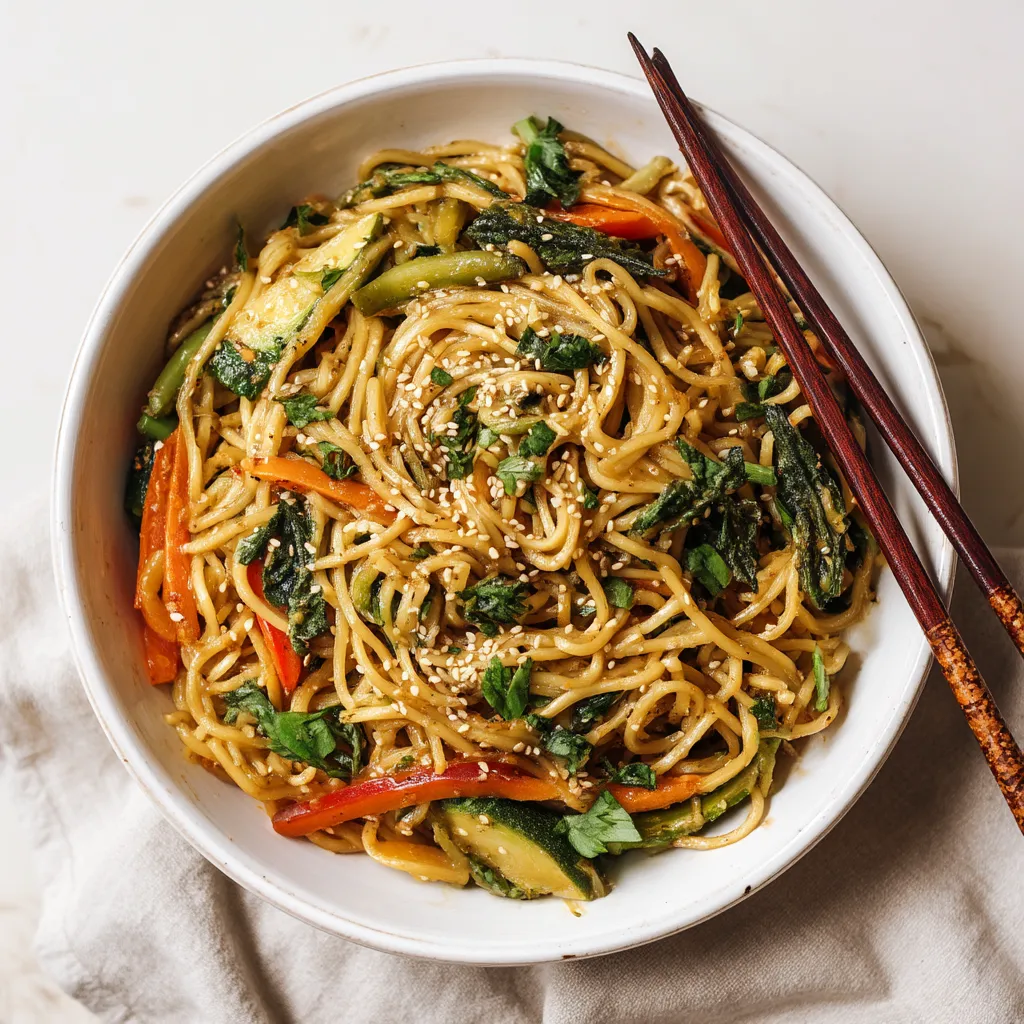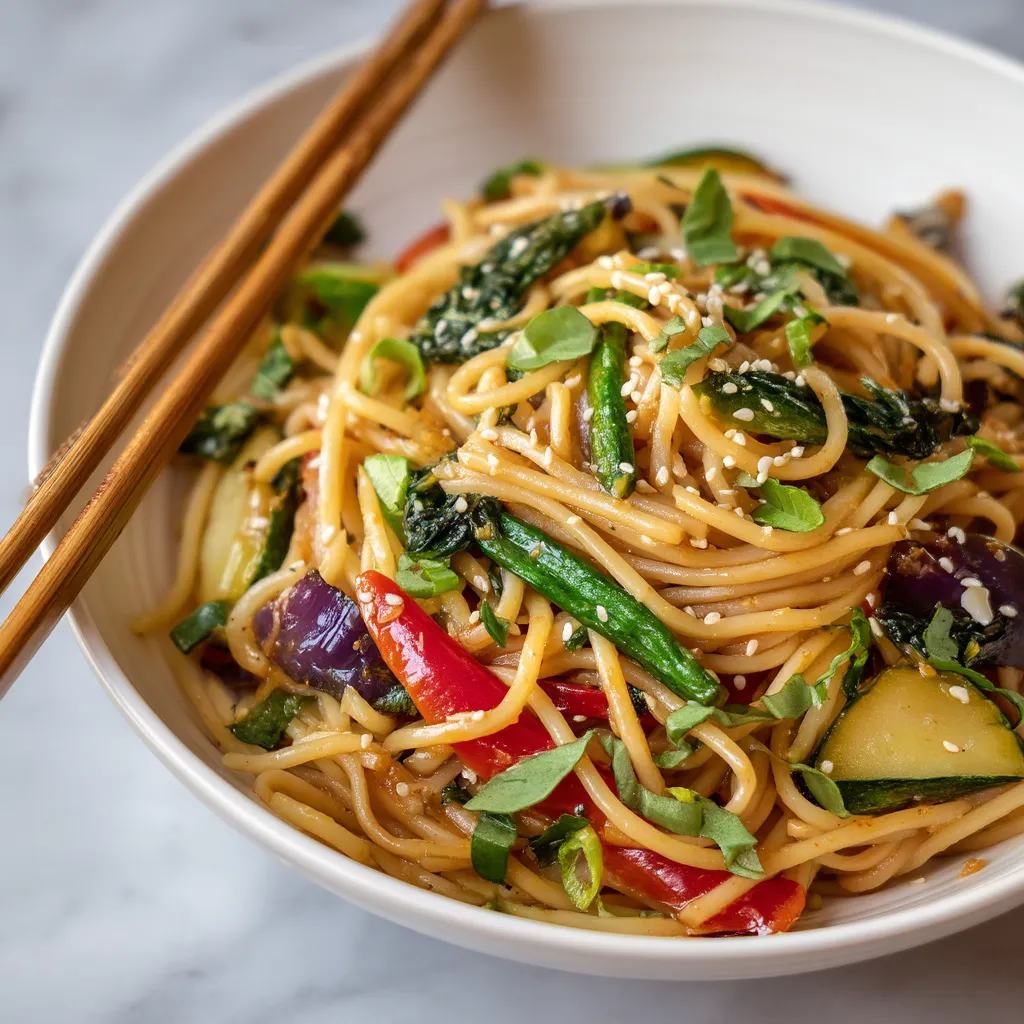 Save It
Save It This vibrant stir-fried noodle dish has become my go-to solution for using up whatever vegetables are in season. The colorful medley of garden veggies combines with a perfectly balanced sauce that coats every strand of noodle for a satisfying meal that comes together in less time than takeout delivery.
I first created this recipe during a busy week when I needed to use up the abundance from my small container garden. My family was so impressed with how restaurant-quality it tasted that it's now in our regular dinner rotation at least twice a month.
Ingredients
- Wheat or rice noodles: form the base of this dish and soak up all the delicious sauce flavors
- Colorful vegetables: provide different textures and nutrients; try to choose a variety of colors for visual appeal
- Fresh ginger and garlic: create an aromatic foundation that elevates the entire dish; use fresh whenever possible
- Soy sauce: provides the savory umami base; look for low-sodium varieties to control saltiness
- Hoisin sauce: adds that classic slightly sweet Chinese flavor that balances the savory elements
- Rice vinegar: brings necessary acidity to cut through the richness; choose unseasoned for best results
- Sesame oil: provides that distinctive nutty flavor that makes the sauce authentic; a little goes a long way
- Maple syrup or brown sugar: balances the sauce with gentle sweetness; adjust to your preference
Step-by-Step Instructions
- Prepare the sauce:
- Whisk together all sauce ingredients until completely smooth and combined. This allows the flavors to start melding while you prepare the other ingredients. The sauce should have a perfect balance of sweet, savory, and tangy notes.
- Heat the aromatics:
- Add oil to your wok and heat until it just begins to shimmer. Introduce garlic and ginger, stirring constantly for exactly 30 seconds. This brief cooking time releases their essential oils without burning these delicate ingredients, which would create bitterness.
- Cook harder vegetables:
- Add carrots, bell pepper, snap peas, and zucchini to the hot wok. Keep everything moving constantly with a tossing motion to ensure even cooking. The vegetables should maintain some crispness while developing slight caramelization at the edges.
- Add leafy vegetables:
- Introduce spinach or bok choy along with green onions. The residual heat will quickly wilt these delicate greens while maintaining their vibrant color. The mixture should now be beautifully colorful with varying textures.
- Combine noodles and sauce:
- Add the precooked noodles to the vegetable mixture along with all of the sauce. Use tongs to continuously lift and turn the ingredients, ensuring every noodle gets evenly coated. The sauce will thicken slightly as it heats, creating a glossy finish.
- Finish and garnish:
- Sprinkle sesame seeds over the finished dish which adds visual appeal and subtle crunch. Add fresh herbs and lime wedges just before serving to brighten the flavors and add a professional finishing touch.
 Save It
Save It You Must Know
- This dish provides a complete nutritional profile with complex carbohydrates, healthy fats, and plenty of vitamins
- The recipe comes together in one pan for minimal cleanup
- Leftovers taste even better the next day as flavors continue to develop
The fresh ginger truly makes this dish special in my opinion. I learned from my neighbor who grew up in Singapore that grating ginger rather than mincing it releases more of its aromatic oils, creating a more fragrant and flavorful base. Every time I make this dish, I think of her generosity in sharing that simple but transformative cooking tip.
Perfect Vegetable Combinations
The beauty of this recipe lies in its adaptability to whatever vegetables you have available. For spring, try asparagus, snow peas, and tender greens. Summer calls for zucchini, yellow squash, and sweet bell peppers. Fall and winter work wonderfully with hearty mushrooms, broccoli, and cabbage. The key is maintaining a balance of colors, textures, and cooking times.
Make It Protein-Rich
Transform this versatile dish into a complete protein-packed meal with easy additions. For plant-based options, toss in cubed firm tofu or tempeh during the last few minutes of cooking. If you eat animal products, quickly stir-fry thinly sliced chicken breast before the vegetables, or add precooked shrimp at the end. My personal favorite is adding a fried egg with a runny yolk on top of each serving, which creates a luxurious sauce when broken.
Cultural Context
This recipe draws inspiration from various Asian cuisines while remaining adaptable to Western ingredients and techniques. Traditional Chinese lo mein uses wheat noodles, while pad Thai would use rice noodles. The sauce combines elements from different traditions, creating a fusion approach that respects the fundamentals of balanced flavor. When serving, consider offering additional condiments like chili oil or fermented black beans to allow each person to customize their bowl.
Storage Secrets
Store leftovers in an airtight container in the refrigerator for up to 3 days. The flavors actually continue to develop overnight, making this dish perfect for meal prep. When reheating, add a tablespoon of water to create steam and prevent the noodles from drying out. For best texture, heat in a skillet rather than microwave, adding a small drizzle of sesame oil to refresh the flavors.
 Save It
Save It Common Questions About Recipes
- → Can I make this dish ahead of time?
Yes! You can prepare the vegetables and sauce up to 2 days ahead and store separately in the refrigerator. Cook the noodles just before serving, as they tend to absorb moisture and may become soggy. When ready to eat, stir-fry everything according to instructions for a fresh-tasting meal in minutes.
- → What protein would work well with these noodles?
This versatile dish pairs wonderfully with many proteins. For plant-based options, try adding cubed tofu or tempeh (pan-fried separately first for best texture). For non-vegan versions, sliced chicken, shrimp, or beef work beautifully. A fried or soft-boiled egg on top adds richness and extra protein.
- → How can I make this dish less spicy?
Simply omit the chili flakes from the sauce for a milder version. The dish will still have plenty of flavor from the garlic, ginger, soy sauce, and other ingredients. If serving guests with different spice preferences, you can serve chili flakes or sriracha on the side.
- → What's the best type of noodle to use?
Medium-thickness wheat noodles like lo mein or udon work wonderfully, but rice noodles offer a lighter alternative and make the dish gluten-free (when paired with tamari instead of soy sauce). Fresh noodles generally have better texture than dried, but either will work. Cook them just until al dente, as they'll continue cooking slightly when tossed with the hot vegetables.
- → Can I use frozen vegetables instead of fresh?
While fresh vegetables provide the best texture and flavor, frozen vegetables can work in a pinch. Thaw and drain them well before adding to the wok to prevent excess moisture. Cook them for slightly less time than fresh vegetables to prevent overcooking. For best results, use individually frozen vegetables rather than pre-mixed medleys, which can cook unevenly.
- → How can I make the sauce thicker?
For a thicker sauce that clings better to the noodles, add 1 teaspoon of cornstarch mixed with 1 tablespoon of cold water at the end of cooking. Pour this slurry into the pan and stir for about 30 seconds until the sauce thickens. You can also reduce the sauce separately before adding to the stir-fry for a more concentrated flavor.